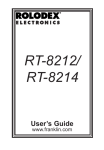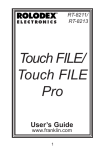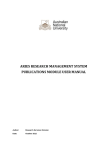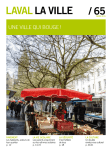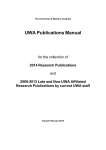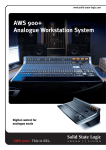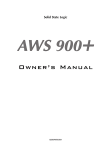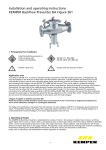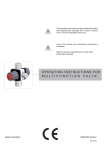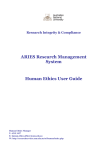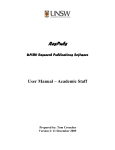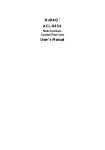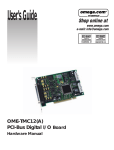Download Publications Collection User Guide - Services
Transcript
THE AUSTRALIAN NATIONAL UNIVERSITY PUBLICATIONS COLLECTION USER GUIDE Author: Research Services Division Date: October 2012 Research Publications Collection User Guide (this page has been left intentionally blank) 2 Research Publications Collection User Guide CONTENTS INTRODUCTION .................................................................................................................................... 5 Types of Publications .......................................................................................................................................... 5 HERDC ELIGIBILITY REQUIREMENTS ........................................................................................... 7 Definition of Research ......................................................................................................................................... 7 Year of Publication .............................................................................................................................................. 8 Author Affiliation ................................................................................................................................................ 8 Measures of Quality ............................................................................................................................................ 8 Electronic Works ................................................................................................................................................. 9 BOOKS ................................................................................................................................................... 10 BOOK CHAPTERS............................................................................................................................... 14 JOURNAL ARTICLES .......................................................................................................................... 18 REFERENCE WORKS ......................................................................................................................... 21 CONFERENCE PAPERS ..................................................................................................................... 22 OTHER CATEGORIES ........................................................................................................................ 26 APPENDIX A - SUMMARY OF PUBLICATION CATEGORIES .................................................. 34 APPENDIX B - CALCULATING THE HERDC SCORE .................................................................. 36 3 Research Publications Collection User Guide (this page has been left intentionally blank) 4 Research Publications Collection User Guide Introduction The Australian National University (ANU) collects information on a wide variety of research outputs published by staff, students and visitors. ANU uses the data collection for many purposes, ranging from management reports, budgetary predictions, internal assessment, ANU Researchers web site, academic promotions, College annual reports and department web sites. In addition to the internal use of publications data the Australian Government, through the Department of Industry, Innovation, Science, Research & Tertiary Education (DIISRTE), requires that all Australian universities report on research income received through research grants and research outputs published by academic staff. The process is known as the Higher Education Research Data Collection (HERDC). The data submitted for HERDC is used to calculate funding which is returned to each university through a number of funding methods such as the Institutional Grants Scheme and the Research Block Grant. ANU’s share of the funding depends on both the number of submitted publications compared with other universities and the total pool of money made available by DIISRTE. The HERDC data is not intended to be a complete list of the research output of each university, rather it provides a ‘level playing field’ to compare ANU with other Australian universities. The latest version of the HERDC Specifications is available on the DIISRTE web site at http://www.innovation.gov.au/Research/ResearchBlockGrants/Pages/HigherEducationResearchDataCol lection.aspx. In 2009 the Australian Government also introduced a data collection called Excellence in Research for Australia (ERA). While the rules for ERA are slightly different to the HERDC rules, both collections are based on research outputs. Publications information is recorded in ARIES, a web based database. All publications should be recorded in ARIES, regardless of whether they are eligible for HERDC and ERA or not. This user guide explains the coding for the different publication categories and the eligibility requirements for the HERDC collection. The Publications Collection Process Types of Publications All research outputs may be collected, regardless of whether the underlying research was carried out at ANU or elsewhere. Publications are classified according to type of publication (called a category), and whether the underlying research was carried out here or elsewhere. The publication categories include: books book chapters conference papers journal articles reports for Government departments and commercial organisations audio-visual recordings computer software creative works such as visual art, musical compositions and performance, art exhibitions legal cases newspaper or magazine articles theses 5 Research Publications Collection User Guide inventions (patents, plant breeders’ rights) entries in encyclopaedias reference works maps translations Publications Collections Officers in Research Schools and Centres are responsible for the following aspects of the data collection: 1. Collect publications information The task of the departmental Publications Collection Officers is to ensure that publications from all staff, students and visiting fellows are entered in the ANU’s publications database (ARIES). Publications information can be gathered from many sources. RSD staff regularly upload publication information from commercial databases and may have entered a lot of items published by your area. Staff from other departments in ANU also add publications where there is collaboration. Collect information about additional publications not in ARIES. Regularly remind staff, students and visiting fellows of the need to report their research publications and the procedure for doing so. Other sources of information are Scopus (for items missed in the automatic uploads), Web of Knowledge, Trove, ANU ePress and the ANU Library. 2. Collect verification material Assemble electronic copies of publications and supporting documentation. Download them from the web or scan paper copies and save the documents in pdf format. The evidence or verification material required for each category is listed in the following sections of this Guide. This evidence is uploaded into ARIES. Foreign Language Publications Foreign language publications are eligible to be counted for HERDC. The same verification evidence is required, in English, as for any other publication. It is not necessary to translate the entire publication, but all relevant sections required for the verification of information to demonstrate that it meets the criteria of the category against which it is being claimed should be translated. This includes evidence that the work meets the definition of research. 3. Evaluate publication eligibility for HERDC Evaluate each publication to determine whether it meets the HERDC Specifications. Contact Research Services Division (RSD) staff at [email protected] for help with any concerns or clarifications. The publications section of RSD web site contains useful resources and information updates at http://researchservices.anu.edu.au/ore/publications/ The eligibility rules for each category are listed in the following sections of this Guide. 4. Enter publication in ARIES Enter publications not already in the ARIES database. Publications already in ARIES do not need to be entered a second time, but you may need to enter additional information. 5. Collect author affiliation statements if required Authors must be affiliated with ANU to be eligible for HERDC. The author’s affiliation is normally stated on the published item. If an affiliation isn’t shown in the publication (by-line or contributors’ information) the authors need to complete and sign an ‘affiliation statement’ or confirm their affiliation via an email showing their electronic signature. 6 Research Publications Collection User Guide 6. Respond to requests from Research Services staff RSD staff may request additional information about publications. Please respond as quickly as possible. You will also routinely receive listings of the publications entered for your department which you can distribute to staff to check for completeness and accuracy. HERDC Eligibility Requirements HERDC eligibility criteria: The item must report original scholarly research, not previously published, The item must be published within the calendar year of collection, The author(s) being claimed must have been affiliated with the ANU when the research leading to the publication was carried out, and The item/work may only be counted once for HERDC even if it meets the requirements of more than one category. Definition of Research The HERDC Specifications provide the following definition: “Research is defined as the creation of new knowledge and/or the use of existing knowledge in a new and creative way so as to generate new concepts, methodologies and understandings. This could include synthesis and analysis of previous research to the extent that it leads to new and creative outcomes. This definition of research is consistent with a broad notion of research and experimental development as comprising of creative work undertaken on a systematic basis in order to increase the stock of knowledge, including knowledge of humanity, culture and society, and the use of this stock of knowledge to devise new applications. This definition of research encompasses pure and strategic basic research, applied research and experimental development. Applied research is original investigation undertaken to acquire new knowledge but directed towards a specific, practical aim or objective (including a client-driven purpose). Activities that support the conduct of research and therefore meet the definition of research include: professional, technical, administrative or clerical support staff directly engaged in activities essential to the conduct of research management of staff who are either directly engaged in the conduct of research or are providing professional, technical, administrative or clerical support or assistance to those staff the activities and training of HDR students enrolled the development of HDR training and courses the supervision of students undertaking HDR training and courses research and experimental development into applications software, new programming languages and new operating systems (this would normally meet the definition of research) Activities that do not support the conduct of research must be excluded, such as: scientific and technical information services general purpose or routine data collection standardisation and routine testing 7 Research Publications Collection User Guide feasibility studies (except into research and experimental development projects) specialised routine medical care commercial, legal and administrative aspects of patenting, copyright or licensing activities routine computer programming, systems work or software maintenance.” Year of Publication The research must have been published in the HERDC year. The date or proof of publication must appear within or on the work being claimed. Letters from authors, editors, creators etc stating that a work was published in a particular year, even though no such date exists within the publication, are not acceptable evidence of year of publication. The year of publication for conference papers is based on the year the paper is published in the proceedings not necessarily the year of the conference. An exception to this may apply for journal articles or conference papers that are produced on CD Rom or are web-based where no date exists within or on the publication. In these instances a letter from the editor of the journal or the conference organiser may be accepted to indicate the year published. Note that this applies only to works where no date exists within the work being claimed. A letter from an editor or conference organiser cannot override a date that is displayed within the work. The year of publication would normally be the earliest of the nominal year, the year indicated as published, the year indicated as printed or the year of copyright. However for online journal articles, the publication date of that article online is accepted as the HERDC year. Author Affiliation Institutional affiliation must be identified by one of the methods below: within or on the work being claimed or where institutional affiliation is not identified within a work, the university must obtain a statement from the author indicating that he or she undertook the research leading to the publication in his or her capacity as a staff member or student of the university. Where a publication shows that an author has affiliation to more than one institution (example, Janet Harvey, Tutor in Economics, University of X, PhD student, University of Y), each Australian university named in that by-line can claim the publication at full value. Adjunct fellows, honorary staff members and staff on leave are considered affiliated with a university if the university is identified in the by-line. Measures of Quality The measure of quality for books and book chapters is that the publisher must meet the HERDC definition of a commercial publisher. For conference papers and journal articles the measure of quality is that the individual paper or article must be peer reviewed prior to publication. Commercial Publisher A commercial publisher is an entity for which the core business is producing books and distributing them for sale. If publishing is not the core business of an organisation but there is a distinct organisational entity devoted to commercial publication and its publications are not completely paid for or subsidised by the parent organisation or a third party, the publisher is acceptable as a commercial publisher. Peer Review For the purposes of HERDC and ERA an acceptable peer review process is one that involves an assessment or review of the research publication in its entirety by independent, qualified experts before publication. Independent in this context means independent of the author. 8 Research Publications Collection User Guide For journal articles, any of the following is acceptable as evidence: the journal is listed on the ARC's ERA 2012 or 2010 journal lists, the journal is listed in Thomson Reuters Web of Knowledge Master Journal List (http://ip-science.thomsonreuters.com/cgi-bin/jrnlst/jlsearch.cgi?PC=MASTER), the journal is classified as ‘refereed’ in the Ulrich’s Knowledgebase (www.ulrichsweb.com) there is a statement in the journal which shows that contributions are peer reviewed, there is a statement or acknowledgement from the journal editor which shows that contributions are peer reviewed or a copy of a reviewer’s assessment relating to the article. Note: RSD maintain a list of peer reviewed journals and conferences within ARIES. Authors and publication collection officers do not need to provide evidence. a statement from an author that a publication was peer reviewed will not be accepted. the existence of a national or international advisory board is not sufficient evidence that all relevant publications are assessed by members of it. Electronic Works Electronic works are eligible to be counted, provided they meet all of the criteria of the publications category against which they are being claimed. 9 Research Publications Collection User Guide BOOKS A BOOKS A book which meets the criteria for HERDC should be classified as A1. If a book does not meet HERDC requirements, enter the publication in ARIES as one of the categories A2 to A5. If the research underpinning the publication was not done at ANU enter the publication as one of ExtA1 to ExtA4. Category A1 Description Authored book meeting HERDC requirements written solely by the author/s must be a substantial work of scholarship must have an ISBN published by organisations which meet the HERDC definition of a commercial independent publisher academics are the target audience Books that may meet this criteria include: critical scholarly texts (for example music, medieval or classical texts) new interpretations of historical events new ideas or perspectives based on established research findings Books that are unlikely to meet this criteria include: A2 textbooks (possibly category A2) anthologies (possibly category A2 or category A4) edited books (category A4) creative works such as novels (category J) translations (category P) revision/new editions (category A3) manuals and handbooks (category A5) Authored book not HERDC-eligible written solely by the author/s must be a substantial work of scholarship published by organisations which do not meet the HERDC definition of a commercial independent publisher. This may include university departments, research institutions e.g. UN, UNESCO, OECD, WHO, vanity presses and privately funded companies or where the intent does not meet the criteria of scholarly research for HERDC e.g. textbooks Books that may meet this criteria include: research monographs published by university departments textbooks (consisting mainly of new combinations of existing knowledge or updating of a body of established knowledge) aimed primarily at a university audience books published by university departments, research institutions, privately funded companies and vanity presses annotated anthologies exhibition catalogues Books that are unlikely to meet this criteria include: creative works such as novels depending mainly upon the imagination of the author (category J) 10 Research Publications Collection User Guide A3 evaluative and investigative government department publications (category K) university Working Papers, Technical Reports, Discussion Papers and similar (category K) textbooks primarily aimed at secondary, primary or pre-school students (category A5) translations without scholarly interpretation (category P2) short/minor translations not involving the translation of an entire book (category P3) translations of published books where the translator is also the author, or where the translator has also written critical scholarly text which accompanies the translation and is a major work of scholarship in its own right (possibly category A1 or category P1) st translated books that are not the 1 edition (category P5) Authored book, revision or new edition A book previously published a collection of previously published articles either by the current author or editor, or by previous author or editor has been brought up-to-date by the substantial addition or alteration of material. Books that are unlikely to meet this criteria include: A4 reprints that do not involve substantial addition or revisions (category A5) revisions/new editions of creative published work (category J) Edited book This category is for the editor(s) of a book consisting of contributions from a number of authors. Books that may meet this criteria include: reference books a monograph or a short series of volumes consisting of contributions from a number of authors. Books that are unlikely to meet this criteria include: A5 edited creative published works (category J) Authored Book not meeting other criteria A published book which does not meet the criteria for other book categories ExtA1 HERDC authored book not researched at ANU Meets the requirements for HERDC, except that the research by the author was done elsewhere. ExtA2 Authored book, not HERDC, not done at ANU Does not meet the requirements for HERDC, and the research by the author was done elsewhere. ExtA4 Edited book not researched at ANU 11 Research Publications Collection User Guide Frequently Asked Questions about Books Q: Can books published by government departments or university departments be included? A: Usually, government departments are not accepted as commercial publishers. Only books published by the Australian Government Publisher (AGP) or CSIRO, and offered for sale, can be included. Books published by University Presses, which have responsibility for distribution as well as printing, can be included. An academic department of a university cannot be accepted as a commercial publisher. Q: How do you know if the book would be considered research? i.e. when do you exclude a textbook or a book written for the general public? A: When determining whether the book is considered original research, think about the reading audience. A major work of scholarship must be directed towards the academic community. Books designed solely for classroom use or general readership (e.g. guidebooks) are not eligible. Often details given in the introduction/preface provide a good indication by stating the aims of the book and its foundations in research. Q: What if the book is a revised edition? A: The book can only be included if proof is provided that the new edition is a substantially revised version of (a) previous edition(s). Often, it is possible to claim new chapters in revised editions as book chapters, instead of claiming the whole book. In this case proof must be provided that these chapters were not included in the previous edition(s) (see following section on book chapters). BOOKS What evidence is collected for HERDC and ERA? Evidence is required for each item claimed, so it is important that you copy sufficient detail from the book and attach it electronically to the publication in ARIES so it can be verified. You should provide evidence from the book of: pages showing the title, author/s, publisher, place of publication, the edition, all dates referring to copyright, the ISBN and edition number page showing the author’s affiliation with your department and the ANU, linking the author to the publication the table of contents the Preface and/or Introduction /or chapter one if there is no Introduction available any bibliography or list of works referenced by the author Please upload the documents to the ARIES publication record 12 Research Publications Collection User Guide (this page has been left intentionally blank) 13 Research Publications Collection User Guide BOOK CHAPTERS B BOOK CHAPTERS B1 A chapter which meets the criteria for HERDC should be classified as B1. If a book chapter does not meet HERDC requirements, enter the publication in ARIES as one of the categories B2 to B5. f the research underpinning the publication was not done at ANU enter the publication as one of ExtB1 to ExtB3. Chapter meeting HERDC requirements written solely by the author/s must be a substantial work of scholarship must have an ISBN published by organisations which meet the HERDC definition of a commercial independent publisher academics are the target audience Book chapters that may meet this criteria include: a scholarly introduction of chapter length to an edited volume, where the content of the introduction reports research and makes a substantial contribution to a defined area of knowledge a critical scholarly text of chapter length critical reviews of current research a new interpretation of historical events or a new idea or perspective based on established research findings. Book chapters that are unlikely to meet this criteria include: B2 textbooks (category B2) entries in reference books such as encyclopaedia (category D) entries in anthologies (category B2) revisions of chapters in edited books (category B3) forewords (category B5) brief introductions (category B5) brief editorials (category B5) appendices (category B5) creative works such as collections of short stories (category J4) translations (category P) Chapter not eligible for HERDC written solely by the author/s published by organisations which do not satisfy the HERDC definition of a commercial independent publisher. This may include university departments, research institutions e.g. UN, UNESCO, OECD, WHO, vanity presses and privately funded companies Book chapters that may meet this criteria include: textbooks (consisting mainly of new combinations of existing knowledge or updating of a body of established knowledge to make it more readily accessible) aimed primarily at a university audience forewords brief introductions brief editorials works already published independently e.g. as journal articles in conference proceedings entries in creative works such as collections of short stories, depending mainly 14 Research Publications Collection User Guide upon the imagination of the author rather than upon a publicly accessible body of agreed fact (possibly category J) entries in evaluative and investigative government department publications entries in translations (but if they are accompanied by a critical scholarly text which is a major work in its own right they may be reported as category B1) entries in annotated anthologies (but if they incorporate a critical scholarly text which is a major work in its own right they may be reported as category B1) Book chapters that are unlikely to meet this criteria include: B3 entries in reference books such as encyclopaedia (category D) translations without scholarly interpretations (category B5 or category P) Revised book chapter Book chapters that may meet this criteria include: B5 revisions of chapters in edited books Published chapter not meeting other criteria A published chapter in a book which does not meet the criteria for other B categories ExtB1 HERDC chapter not researched at ANU Meets the requirements for HERDC, except that the research by the author was done elsewhere. ExtB2 Non HERDC chapter not researched at ANU Does not meet the requirements for HERDC and the research by the author was done elsewhere. ExtB3 Revised chapter not researched at ANU Revised chapter, research by the author was done elsewhere. 15 Research Publications Collection User Guide Frequently Asked Questions about Chapters Q: Can a chapter be included if it was previously published as a journal article or conference paper? A: It cannot be included as category B1 but may be entered as B5. Previously published work is not eligible for HERDC. If the same work has been published in more than one form in the same year, it can only be counted for HERDC once. Note that journal articles and conference papers will generally score higher than book chapters if there are several chapters by the same author in the book. Q: What if the book is a revision, but the chapter is a new addition? A: If the chapter contains completely new research and was not published in the previous edition, it can be accepted. If the chapter has only been revised it cannot count as category B1 but may be entered as B3. If you are claiming a new chapter in a new edition, you will need to show that the chapter was not in previous edition(s) (ie. provide the contents list of the previous edition). Q: What constitutes a work of reference? How long does the entry have to be? A: Any entry in an encyclopaedia, anthology, or dictionary (e.g. The Oxford Guide to Romantic Literature) will not be eligible for HERDC unless the work is over 4000 words and it is a critical scholarly text reporting previously unpublished research. BOOK CHAPTERS What evidence is collected for HERDC and ERA? Evidence is require for each item claimed, so it is important that you copy sufficient detail from the book and attach it to the publication record in ARIES so it can be verified. You should provide copied evidence from the book of: pages showing the title, author/s, publisher, place of publication, the edition, all dates referring to copyright and the ISBN page showing the author’s affiliation with the ANU (eg. List of contributors) the table of contents the Preface and/or Introduction or Chapter 1 if there is no Introduction the claimed chapter (in full) any bibliography or list of works referenced by the author Please upload the documents to the ARIES publication record 16 Research Publications Collection User Guide (this page has been left intentionally blank) 17 Research Publications Collection User Guide JOURNAL ARTICLES C JOURNAL ARTICLES C1 An article which meets the criteria for HERDC-should be classified as C1. If a journal article does not meet HERDC requirements enter the article in ARIES with one of the categories C2 to C5. f the research underpinning the publication was not done at ANU enter the publication as one of ExtC1 to ExtC4. Journal article meeting HERDC requirements written solely by the author/s must be a substantial work of scholarship in a refereed scholarly journal which has an ISSN Journal articles that may meet this criteria include: commentaries and communications of original research research notes letters to journals, provided that the letter satisfies the definition of research critical scholarly texts which appear in article form articles reviewing multiple works or an entire field of research invited papers to journals articles in journals which are targeted to both scholars and professionals article in a stand-alone series Journal articles that are unlikely to meet this criteria include: C2 letters to the editor (category C5) case studies (category C5) articles designed to inform practitioners on existing knowledge in a professional field (category C5) articles in newspapers and popular magazines (category N) editorials (category C5) book reviews (category C5) brief commentaries and communications of original research (category C5) reviews of art exhibitions, concerts, theatre productions (category C5) Non-refereed article in scholarly journal non-refereed work of scholarship published in a scholarly or professional journal controlled by an editorial board Include: articles that are sets of guidelines or summaries of the state of knowledge in an area generally intended to inform practitioners in a professional field medical case histories Exclude: C3 editorials (category C5) letters to the editor (category C5) book reviews (category C5) non-scholarly, non-research articles (category C5) articles in newspapers and popular magazines (category N) translations (category P) Refereed letter, note etc in scholarly journal it is a refereed communication (including editorial commentary) and 18 Research Publications Collection User Guide it is published in a scholarly or professional journal controlled by an editorial board. Journal articles that may meet this criteria include: a commentary or brief communication of original research not subject to peer review Journal articles that are unlikely to meet this criteria include: C4 Editor of scholarly journal C5 a non-scholarly, non-research article (possibly include it in category C5) an article in a newspaper or popular magazine (possibly include it in category N). letters to the editor that are subject to peer review (unless eligible for category C1) critical scholarly texts that are subject to peer review but are not substantial works of scholarship contributions to journals that are peer reviewed if the journal does not have an ISSN book reviews and review articles (category C5) a journal is edited by members of staff in which one or more members of institutional staff are identified as having editorial responsibility for an ongoing series Non-refereed short journal contribution A published journal article which does not meet the criteria for other C categories C99 Journal article imported from Scopus / other database RSD staff import publications from external databases into ARIES. Completion of the record is required. The C99 category is to be changed another C category once the record has been updated. ExtC1 HERDC journal article not researched at ANU Meets the requirements for HERDC, except that the research by the author was done elsewhere. ExtC2 Journal article not HERDC, not at ANU Does not meet the requirements for HERDC and the research by the author was done elsewhere. ExtC4 Editor of journal, not done at ANU Journal was edited while the author was not at ANU. 19 Research Publications Collection User Guide Frequently Asked Questions about Journal Articles Q: How do I know if the journal is refereed? A: Check the referee status of the journal in ARIES. If the journal is not in ARIES the RSD staff will investigate. Q: What about journals published electronically or on the Web? A: As long as the journal has an ISSN and is refereed, it can be included. Q: What if the editor states that the journal is refereed, but it does not have an ISSN? A: Journals without an ISSN are not eligible for HERDC. Journals having an ISBN, as distinct from an ISSN, need special approval to be included. Research Services staff will arrange this clearance on your behalf. Contact [email protected] for assistance. JOURNAL ARTICLES What evidence is collected for HERDC and ERA? Evidence is required for each item claimed, so it is important that you copy sufficient detail from the article and journal and upload it in ARIES so it can be verified. You should provide: a copy or offprint of the article including the by-line or footnote copies of pages showing the journal title, ISSN, and dates if they are not provided in the copy or offprint of the article proof of the affiliation of the authors with your department and ANU if it is not shown in the article Please upload the documents the ARIES publication record. (this pagetohas been left intentionally blank) 20 Research Publications Collection User Guide REFERENCE WORKS D REFERENCE WORKS D1 Items which meet all the criteria for HERDC should be classified as A1 or B1. Entry in prestigious reference work This category is used to claim for substantial research contributions to scholarly publications such as dictionaries, encyclopaediae, guidelines, manuals and handbooks. It is not necessary for the publisher to meet the HERDC criteria of a commercial publisher. Reference works that may meet this criteria include: a single author’s contribution to an edited reference work a series of contributions to different sections of an edited reference work by the same author(s) substantial revisions/additions to previously published reference works bibliographies and annotated bibliographies Reference works that are unlikely to meet this criteria include: D2 entire reference works written solely by the author(s) ( category A2) minor revisions/additions to previously published reference works (exclude) Entry in minor reference work Minor review or entry in an encyclopaedia, dictionary, manual or handbook ExtD1 Entry in major work, not researched at ANU Research by the author not done at ANU. ExtD2 Entry in reference work, not researched at ANU Research by the author not done at ANU. 21 Research Publications Collection User Guide CONFERENCE PAPERS E CONFERENCE PAPERS E1 A conference paper which meets the criteria for HERDC should be classified as E1. If a conference paper does not meet HERDC requirements, you should enter it in ARIES with one of the categories E2 to E5 or ExtE1 to ExtE4. Conference paper meeting HERDC requirements written solely by the author/s substantial work of scholarship entire paper must be refereed and published conference of national or international significance Conference papers that are unlikely to meet this criteria include: E2 abstracts (category E3) a handout (category E5) a poster presentation (category E3) Written version of conference presentations it is a written version of a conference presentation it is a non-refereed/peer reviewed paper and it was subsequently published Conference papers that are unlikely to meet this criteria include: E3 papers presented at workshops, minor seminars and conferences not regarded as having national significance (category E5) papers presented at conferences but not subsequently published (category E5) abstracts (category E3) Abstract or extract of paper extracts or synopses of conference papers that will not subsequently be published Conference papers that may meet this criteria include: E4 poster papers abstracts Edited conference proceedings edited volume of conference proceedings in which one or more members of university staff are identified as having editorial responsibility for the proceedings Conferences that are unlikely to meet this criteria include: edited volumes in which the university staff member is on the editorial advisory board but is not one of the listed editors of the volume (exclude completely) E5 Conference paper not meeting other criteria A conference publication does not meet the criteria for other E categories E99 Conference paper from Scopus / other database RSD staff import publications from external databases into ARIES. Completion of the record is required. The E99 category is to be changed another E category once the record has been updated. 22 Research Publications Collection User Guide ExtE1 HERDC Conference paper, not done at ANU Meets the requirements for HERDC, except that the research by the author was done elsewhere. ExtE2 Conference paper not HERDC, not done at ANU Does not meet the requirements for HERDC and the research by the author was done elsewhere. ExtE4 Edited conference proceedings, not at ANU Conference was edited while the author was not at ANU. 23 Research Publications Collection User Guide Frequently Asked Questions about Conference Papers Q: How do I know if the conference was refereed? A: The peer review status of a conference will be investigated by RSD staff. If in doubt add the publication as HERDC eligible and RSD staff will validate it. Q: What if conference papers were formally assessed by an editorial board or an expert advisory panel / committee / board? A: If papers were only assessed by an editorial board, and there was no external peer review, the paper will not be eligible for HERDC. On the other hand, a review by an expert advisory panel / committee / board independent of the conference organisers can be accepted. CONFERENCE PUBLICATIONS What evidence is collected for HERDC and ERA? Evidence is required for each paper claimed, so it is important that you copy sufficient evidence so it can be verified. You should provide: a full copy or offprint of the paper copies or printouts of the conference and proceedings titles, and pages showing the editor, the authors, the publisher, date of publication, the ISBN or ISSN if issued proof of the affiliation of the authors with your department and ANU if it is not shown in the paper Please upload the evidence to the ARIES publication record 24 Research Publications Collection User Guide (this page has been left intentionally blank) 25 Research Publications Collection User Guide OTHER CATEGORIES G G1 COMPUTER SOFTWARE Software – Computer Program Computer program, innovative, commercial innovative software products of commercial quality offered for sale or distributed as shareware through a recognised publisher or distributor Include: system software (i.e. low-level programs that interact with the computer at a very basic level such as operating systems, compilers and utilities for managing computer resources) application software (i.e. software that performs a specific task or function such as word-processing, creation of spreadsheets, generation of graphics, facilitating email, etc.) innovative software products designed for scholars computer software versions other than the first version only if significantly improved Exclude: G2 Computer program, not commercial ExtG1 multimedia products with limited human interactive ability (possibly category F) creative multimedia productions (possibly category J) innovative software products designed primarily for undergraduate and postgraduate university students software designed primarily for secondary, primary or pre-school students Software not developed at ANU Work not done while the author was at ANU. I INVENTION General criteria: This category refers to full patents (or equivalent) on specific products or processes granted for the first time, either in Australia or overseas The inventor being claimed must have been a staff member or student of the ANU when the research leading to the patent was carried out I1 Patent eligible for HERDC (2001 only) This category is used to claim for patents which must: be for a product or process for which a full patent (or its equivalent) has been granted be granted for the first time in 2001 be either owned by the University, a commercial subsidiary, controlled entity or affiliated institution or the research leading to the patent must have been 26 Research Publications Collection User Guide I2 undertaken at the ANU not include multiple rights for the same product or process not include applications for which no determination has been made on patent rights Granted Patent This category is used to claim for patents which must: I5 be for a product or process for which a full patent (or its equivalent) has been granted be granted for the first time in the nominated year be either owned by the University, a commercial subsidiary, controlled entity or affiliated institution or the research leading to the patent must have been undertaken at the ANU not include multiple rights for the same product or process not include applications for which no determination has been made on patent rights Provisional patent Application for a provisional patent for an invention. I6 Plant Breeder's Rights As defined in relevant legislation, Plant Breeder‘s Rights are proprietary rights held by breeders of certain new varieties of plants and fungi. Such rights are legally enforceable and give exclusive commercial rights to market a new variety or its propagating material for the duration of the Plant Breeder‘s Rights. I7 Registered Design a right granted for new and distinctive designs. Once a registered design has been examined and certified, the owner has an exclusive right to use, license and/or sell the registered design, and to enforce it against an infringer. In this context design refers to features which, when applied to a product, render it unique in appearance. This may include shape, pattern or ornamentation. I8 NHMRC Endorsed Guidelines Guidelines endorsed by the National Health and Medical Research Council (NHMRC) are eligible for inclusion in ERA submissions. NHMRC endorsed guidelines include those on population health, clinical practice, and ethics. Such guidelines may be produced by groups external to the NHMRC, or else developed by NHMRC with the assistance of expert working groups. J CREATIVE WORK: Non-Traditional Eligible Research Output Types (ERA only) Sub-categories of Original Creative works are as follows: Original Creative Works; Live Performance of Creative Works; Recorded/Rendered Creative Works; and Curated or Produced Substantial Public Exhibitions and Events. CREATIVE WORK PORTFOLIO: (multiple works for ERA) 27 Research Publications Collection User Guide Original creative work portfolio Original creative work portfolio Collection of individual works meeting ERA Specifications CREATIVE WORKS: Original work J1 Visual art work ERA eligible A research output such as a fine arts and crafts work, diagram, map, photographic image, sculpture or installation which meets ERA specifications. J1n Visual art work not ERA eligible A research output such as a fine arts and crafts work, diagram, map, photographic image, sculpture or installation which does not meet ERA specifications J2 Design/architectural work ERA eligible A research output such as architectural or engineering design which meets ERA specifications J2n Design/architectural work not ERA eligible A research output such as architectural or engineering design which does not meet ERA specifications J3 Textual work ERA eligible A research output such as a novel or collection of poems which meets ERA specifications J3n Textual work not ERA eligible A research output such as a novel or collection of poems which does not meet ERA specifications J4 Other original creative work ERA eligible Other original creative works that do not fit the other research output types. For example, scholarly editions, scholarly translations and public policy reports may be submitted under this category, provided they meet the relevant eligibility criteria, including meeting the definition of research. J4n Other original creative work not ERA eligible Other original creative works which do not meet ERA specifications. CREATIVE WORKS: Live Performance J5 Music ERA eligible 28 Research Publications Collection User Guide New work or a demonstrably new or innovative interpretation or production of an existing work which meets ERA specifications. J5n Music not ERA eligible Work or a demonstrably new or innovative interpretation or production of an existing work which does not meet ERA specifications J6 Play ERA eligible New work or a demonstrably new or innovative interpretation or production of an existing work which meets ERA Specifications. J6n Play not ERA eligible Work or a demonstrably new or innovative interpretation or production of an existing work which does not meet ERA Specifications. J7 Dance ERA eligible New work or a demonstrably new or innovative interpretation or production of an existing work which meets ERA Specifications. J7n Dance not ERA eligible Work or a demonstrably new or innovative interpretation or production of an existing work which meets ERA Specifications. J8 Other performance ERA eligible Other live performance meeting ERA Specifications J8n Other performance ERA eligible Other live performance not meeting ERA Specifications CREATIVE WORKS: Recorded or Rendered work J9 Film, video ERA eligible Film or video meeting ERA Specifications. J9n Film, video not ERA eligible Film or video not meeting ERA Specifications J10 Recorded performance ERA eligible Recorded performance meeting ERA Specifications J10n Recorded performance ERA eligible Recorded performance not meeting ERA Specifications J11 Inter-arts ERA eligible 29 Research Publications Collection User Guide J11n Inter-arts not ERA eligible J12 Digital creative work ERA eligible Creative 3D models, including digital outputs of architectural and design projects, computer programs, games and visual artworks meeting ERA Specifications. J12n Digital creative work not ERA eligible Creative 3D models, including digital outputs of architectural and design projects, computer programs, games and visual artworks not meeting ERA Specifications. J13 Website/Web exhibition ERA eligible Recorded/rendered creative works meeting ERA Specifications. Curated web based exhibitions of the creative work of others must be submitted as Curated or Produced Substantial Public Exhibitions and Events. J13n Website/Web exhibition not ERA eligible Recorded/rendered creative works not meeting ERA Specifications. J14 Other recorded or rendered work ERA eligible J14n Other recorded or rendered work not ERA eligible CREATIVE WORKS: Curated exhibition or event The Curated or Produced Substantial Public Exhibitions and Events research output type is specifically aimed at research outputs produced by curators rather than artists. J15 Web-based exhibition ERA eligible The curation and/or production of an internet website presenting a collection of creative works where the internet is the medium of the exhibited works meeting ERA Specifications. J15n Web-based exhibition not ERA eligible The curation and/or production of an internet website presenting a collection of creative works where the internet is the medium not meeting ERA Specifications J16 Exhibition or event ERA eligible J16n Exhibition or event not ERA eligible J17 Festival ERA eligible Organisation of a festival meeting ERA Specifications J17n Festival ERA eligible Organisation of a festival not meeting ERA Specifications J18 Other curated event ERA eligible Curated or substantial public exhibitions and events that do not fit into the above sub- 30 Research Publications Collection User Guide categories and which meet ERA Specifications. J18n Other curated event not ERA eligible Curated or substantial public exhibitions and events that do not fit into the above subcategories and do not meet ERA Specifications. K REPORTS K1 Reports/working papers must be non-confidential. Reports, working & discussion papers published This category is used to claim for major reports that are widely available in the public domain. Include: major evaluative and investigative government department reports reviews of existing practices Exclude: K2 reports that are only available internally (possibly category K2) confidential reports unpublished reports a chapter or section of a major report (possibly category B2, if substantial) Minor reports available internally This category is used to claim for minor reports/working papers that are only available internally (i.e. to other ANU departments). Include: university department reports/working papers that are not disseminated widely outside the university including reports used to complement internal department seminars Exclude: ExtK1 confidential reports/working papers (exclude completely) unpublished reports/ working papers (exclude completely) a chapter or section of a minor report working papers (exclude completely) Report, not researched at ANU Report where work was not done at ANU P P1 TRANSLATIONS Translation, substantial critical commentary Translation of with substantial critical commentary translation of with substantial critical commentary which is not eligible for the HERDC must be a substantial work of scholarship may be published by organisations which do not satisfy the HERDC definition of a commercial independent publisher. This may include university departments, 31 Research Publications Collection User Guide research institutions e.g. UN, UNESCO, OECD, WHO, vanity presses and privately funded companies Exclude: P2 translations with minimal or no scholarly interpretation (category P2) short/minor translations not involving the translation of an entire book (category P5) translations of published books where the translator is also the author translations where the translator has also written critical scholarly text which accompanies the translation and is a major work of scholarship in its own right (possibly category A1 or category A2) st translated books that are not the 1 edition (category P5) Translation with minimal critical commentary Translation of book with minimal critical commentary P5 translation of a book with minimal critical commentary must be a substantial work of scholarship may be published by organisations which do not satisfy the HERDC definition of a commercial independent publisher. This may include university departments, research institutions, vanity presses Translation not meeting other criteria A published, publicly available translation which does not meet the criteria for other P categories translation of a complex website into a second language OTHER CATEGORIES Legal case L1 Legal case Map M1 Map Newspaper or magazine article N1 Newspaper or magazine article Obituary X1 Obituary Thesis T1 Thesis Audiovisual material F1 Audio visual: documentary or non-creative work 32 Research Publications Collection User Guide 33 Research Publications Collection User Guide Appendix A - Summary of Publication Categories Category Publication A1 Authored book meeting HERDC requirements A2 Authored book not HERDC-eligible A3 Authored book, revision or new edition A4 Edited book A5 Authored book not meeting other criteria ExtA1 HERDC authored book not researched at ANU ExtA2 Authored book, not HERDC, not done at ANU ExtA4 Edited book not researched at ANU B1 Chapter meeting HERDC requirements B2 Chapter not eligible for HERDC B3 Revised book chapter B5 Published chapter not meeting other criteria ExtB1 HERDC chapter not researched at ANU ExtB2 Non HERDC chapter not researched at ANU ExtB3 Revised chapter not researched at ANU C1 Journal article meeting HERDC requirements C2 Non refereed article in scholarly journal C3 Letter, note etc in scholarly journal C4 Editor of scholarly journal C5 Non-refereed short journal contribution C99 Article imported from Scopus / other Database ExtC1 HERDC journal article not researched at ANU ExtC2 Journal article not HERDC, not at ANU ExtC4 Editor of journal, not done at ANU D1 Entry in prestigious reference work D2 Entry in minor reference work ExtD1 Entry in major work, not researched at ANU ExtD2 Entry in ref work, not researched at ANU E1 Conference paper meeting HERDC requirements E2 Written version of conference presentation E3 Abstract or extract of paper E4 Edited conference proceedings E5 Conference paper not meeting other criteria E99 Conference paper created from Scopus upload ExtE1 HERDC Conference paper, not done at ANU ExtE2 Conference paper not HERDC, not done at ANU ExtE4 Edited conference proceedings, not at ANU F1 Audio visual: documentary or non-creative work G1 Computer program, innovative, commercial G2 Computer program, not commercial ExtG1 Computer program not developed at ANU I1 Patent eligible for HERDC (2001 only) I2 Granted Patent I5 Provisional patent I6 Plant Breeder's Rights I7 Registered design HERDC * ERA * * * * * * * * * * * * * * 34 Research Publications Collection User Guide I8 NHMRC endorsed guidelines J1 Visual art work ERA eligible J1n Visual art work not ERA eligible J2 Design/architectural work ERA eligible J2n Design/architectural work not ERA eligible J3 Textual work ERA eligible J3n Textual work not ERA eligible J4 Other original creative work ERA eligible J4n Other original creative work not ERA eligible J5 Music ERA eligible J5n Music not ERA eligible J6 Play ERA eligible J6n Play not ERA eligible J7 Dance ERA eligible J7n Dance not ERA eligible J8 Other performance ERA eligible J8n Other performance not ERA eligible J9 Film, video ERA eligible J9n Film, video not ERA eligible J10 Recorded Performance ERA eligible J10n Recorded Performance not ERA eligible J11 Inter-arts ERA eligible J11n Inter-arts not ERA eligible J12 Digital creative work ERA eligible J12n Digital creative work not ERA eligible J13 Website/Web exhibition ERA eligible J13n Website/Web exhibition not ERA eligible J14 Other recorded or rendered work ERA eligible J14n Other recorded or rendered work not ERA eligible J15 Web-based exhibition ERA eligible J15n Web-based exhibition not ERA eligible J16 Exhibition or Event ERA eligible J16n Exhibition or Event not ERA eligible J17 Festival ERA eligible J17n Festival not ERA eligible J18 Other curated event ERA eligible J18n Other curated event not ERA eligible - Original creative work portfolio K1 Reports, working & discussion papers published K2 Minor reports available internally L1 Legal case M1 Map N1 Newspaper / magazine article O1 Other publication P1 Translation, substantial critical commentary P2 Translation with minimal critical commentary P5 Translation not meeting other criteria T1 Thesis * * * * * * * * * * * * * * * * * * * * 35 Research Publications Collection User Guide Appendix B - Calculating the HERDC score A score is assigned to each ANU author on a HERDC-eligible publication. ARIES automatically calculates the score for each author and assigns the score to the department of that author. The scores are totalled for each department, and then totalled for all ANU authors and all HERDC categories and reported to DIISRTE. DIISRTE applies a weighting to the score for each publication: Category Publication Weighting A1 Authored book meeting HERDC requirements 5 B1 Book chapter meeting HERDC requirements 1 C1 Journal article meeting HERDC requirements 1 E1 Conference paper meeting HERDC requirements 1 The score for each HERDC-eligible publication is based on the proportion of ANU authors to the total number of authors. The following algorithm is used: Number of departmental authors * weighting of publication category total authors Example: you have a book written by two authors. Both authors are in your department: 2x5= 5 2 Example: you have a journal article written by three authors. Two are from your department and one is from another university: 2 * 1 = 0.67 3 Calculations For Publications with Multiple Authors and Joint Appointments Each ANU department is credited with the points for its component of the author’s appointment. Example: you have a conference paper written by a total of seven authors. One is a full appointment from your department, one is a half appointment from your department, one is a third appointment from your department, and the other four are from other institutions. For your department the score is calculated thus: 1 + 0.5 + 0.33 *1 = 0.261 7 36




































